Strategic Resourcing and Talent Management: Employee Turnover Analysis
VerifiedAdded on 2023/01/13
|7
|1907
|66
Report
AI Summary
This report delves into the critical aspects of strategic resourcing and talent management within organizations. It begins by emphasizing the importance of aligning talent management strategies with overall business objectives. The main body of the report focuses on employee retention and turnover rates, providing definitions and calculations, and discussing the associated costs and benefits. It explores various strategies to increase retention, including compensation, work environment, training, and work-life balance, and examines factors influencing employee decisions to leave a company, including exit strategies and ethical considerations. The report emphasizes the importance of exit interviews, succession planning, maintaining positivity, and protecting the company's reputation during employee departures. It concludes by highlighting the absence of a universally applicable ideal turnover rate and stresses the significance of analyzing the reasons behind employee turnover and the industry-specific nature of turnover rates. The report references several academic sources to support its analysis.
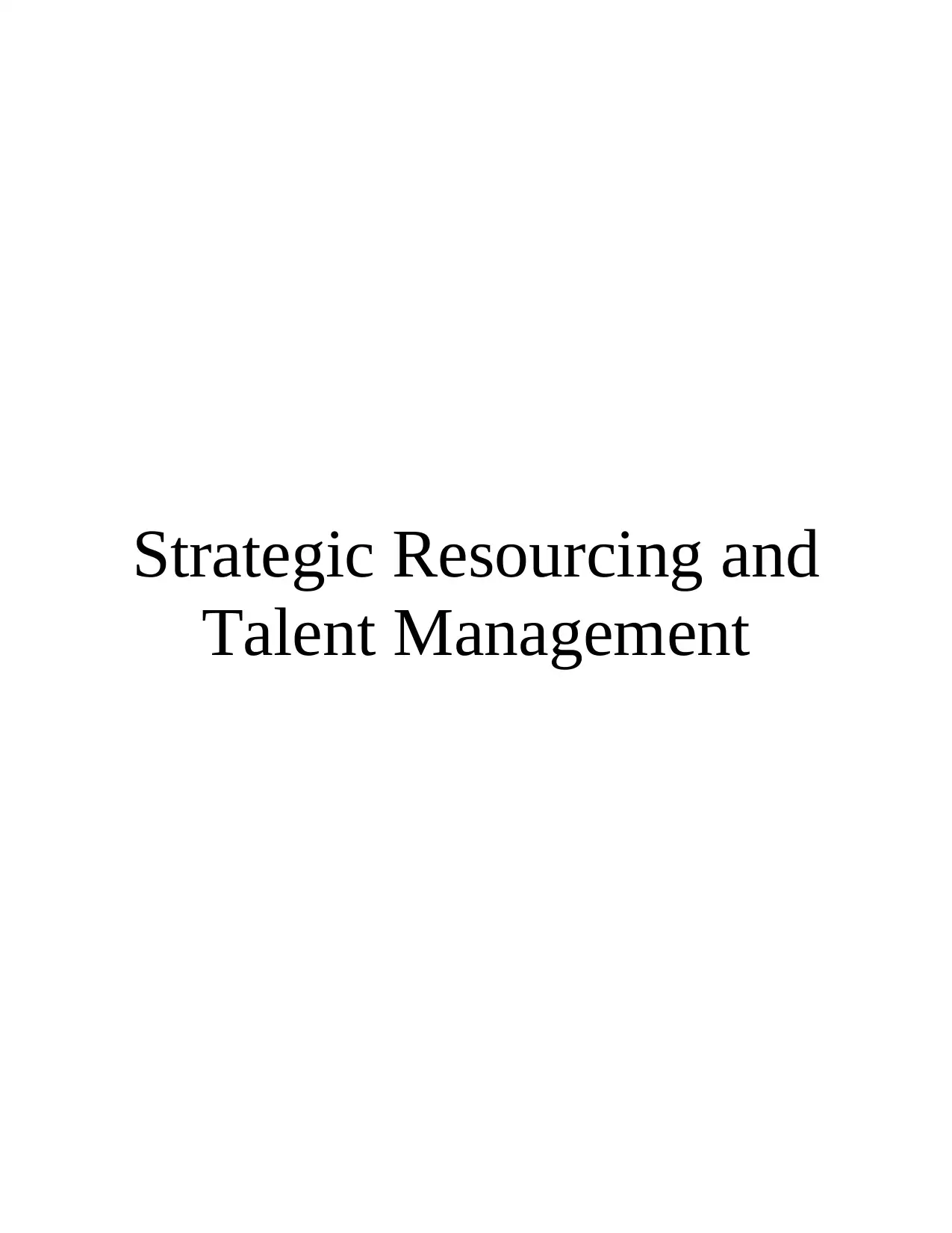
Strategic Resourcing and
Talent Management
Talent Management
Paraphrase This Document
Need a fresh take? Get an instant paraphrase of this document with our AI Paraphraser
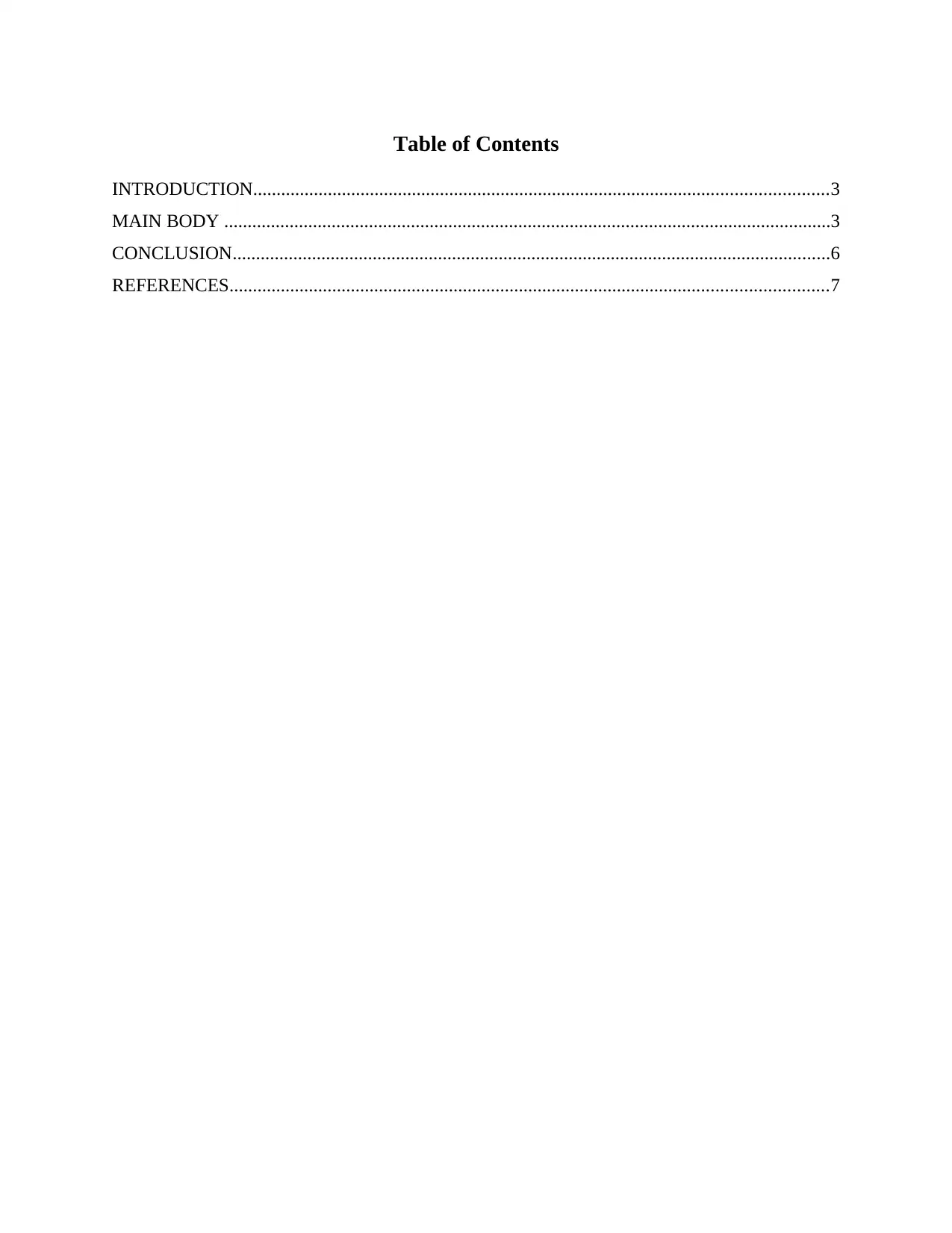
Table of Contents
INTRODUCTION...........................................................................................................................3
MAIN BODY ..................................................................................................................................3
CONCLUSION................................................................................................................................6
REFERENCES................................................................................................................................7
INTRODUCTION...........................................................................................................................3
MAIN BODY ..................................................................................................................................3
CONCLUSION................................................................................................................................6
REFERENCES................................................................................................................................7
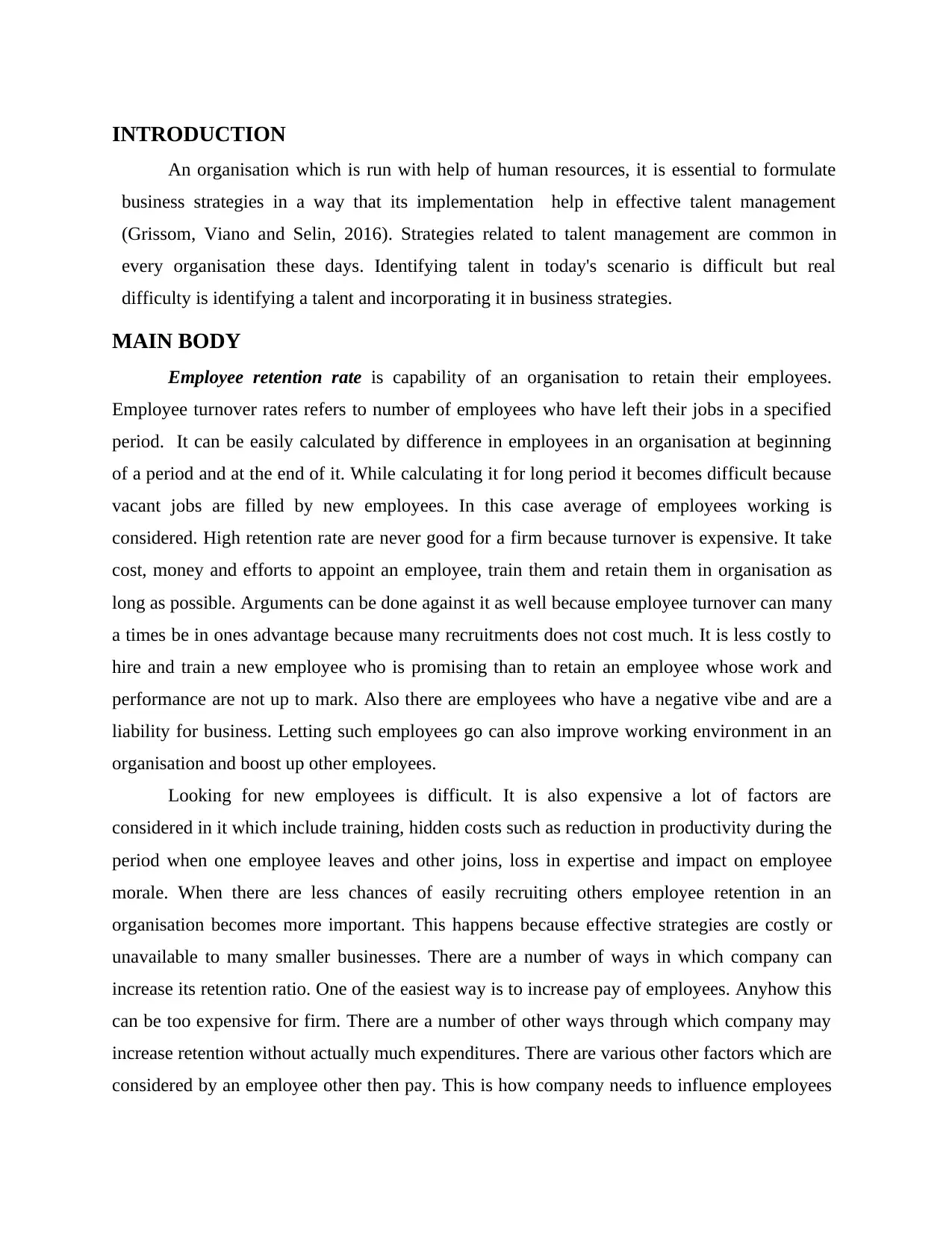
INTRODUCTION
An organisation which is run with help of human resources, it is essential to formulate
business strategies in a way that its implementation help in effective talent management
(Grissom, Viano and Selin, 2016). Strategies related to talent management are common in
every organisation these days. Identifying talent in today's scenario is difficult but real
difficulty is identifying a talent and incorporating it in business strategies.
MAIN BODY
Employee retention rate is capability of an organisation to retain their employees.
Employee turnover rates refers to number of employees who have left their jobs in a specified
period. It can be easily calculated by difference in employees in an organisation at beginning
of a period and at the end of it. While calculating it for long period it becomes difficult because
vacant jobs are filled by new employees. In this case average of employees working is
considered. High retention rate are never good for a firm because turnover is expensive. It take
cost, money and efforts to appoint an employee, train them and retain them in organisation as
long as possible. Arguments can be done against it as well because employee turnover can many
a times be in ones advantage because many recruitments does not cost much. It is less costly to
hire and train a new employee who is promising than to retain an employee whose work and
performance are not up to mark. Also there are employees who have a negative vibe and are a
liability for business. Letting such employees go can also improve working environment in an
organisation and boost up other employees.
Looking for new employees is difficult. It is also expensive a lot of factors are
considered in it which include training, hidden costs such as reduction in productivity during the
period when one employee leaves and other joins, loss in expertise and impact on employee
morale. When there are less chances of easily recruiting others employee retention in an
organisation becomes more important. This happens because effective strategies are costly or
unavailable to many smaller businesses. There are a number of ways in which company can
increase its retention ratio. One of the easiest way is to increase pay of employees. Anyhow this
can be too expensive for firm. There are a number of other ways through which company may
increase retention without actually much expenditures. There are various other factors which are
considered by an employee other then pay. This is how company needs to influence employees
An organisation which is run with help of human resources, it is essential to formulate
business strategies in a way that its implementation help in effective talent management
(Grissom, Viano and Selin, 2016). Strategies related to talent management are common in
every organisation these days. Identifying talent in today's scenario is difficult but real
difficulty is identifying a talent and incorporating it in business strategies.
MAIN BODY
Employee retention rate is capability of an organisation to retain their employees.
Employee turnover rates refers to number of employees who have left their jobs in a specified
period. It can be easily calculated by difference in employees in an organisation at beginning
of a period and at the end of it. While calculating it for long period it becomes difficult because
vacant jobs are filled by new employees. In this case average of employees working is
considered. High retention rate are never good for a firm because turnover is expensive. It take
cost, money and efforts to appoint an employee, train them and retain them in organisation as
long as possible. Arguments can be done against it as well because employee turnover can many
a times be in ones advantage because many recruitments does not cost much. It is less costly to
hire and train a new employee who is promising than to retain an employee whose work and
performance are not up to mark. Also there are employees who have a negative vibe and are a
liability for business. Letting such employees go can also improve working environment in an
organisation and boost up other employees.
Looking for new employees is difficult. It is also expensive a lot of factors are
considered in it which include training, hidden costs such as reduction in productivity during the
period when one employee leaves and other joins, loss in expertise and impact on employee
morale. When there are less chances of easily recruiting others employee retention in an
organisation becomes more important. This happens because effective strategies are costly or
unavailable to many smaller businesses. There are a number of ways in which company can
increase its retention ratio. One of the easiest way is to increase pay of employees. Anyhow this
can be too expensive for firm. There are a number of other ways through which company may
increase retention without actually much expenditures. There are various other factors which are
considered by an employee other then pay. This is how company needs to influence employees
⊘ This is a preview!⊘
Do you want full access?
Subscribe today to unlock all pages.

Trusted by 1+ million students worldwide
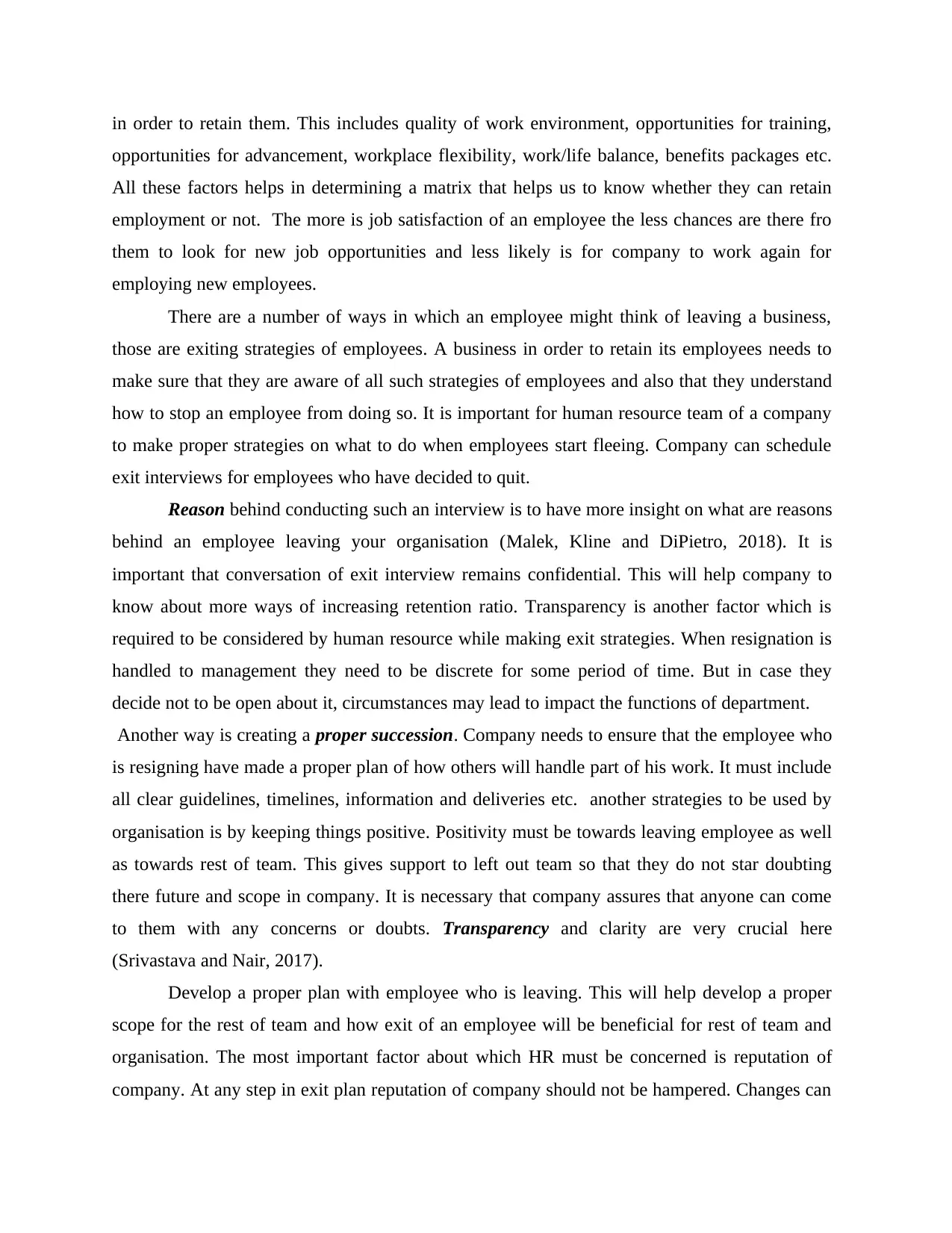
in order to retain them. This includes quality of work environment, opportunities for training,
opportunities for advancement, workplace flexibility, work/life balance, benefits packages etc.
All these factors helps in determining a matrix that helps us to know whether they can retain
employment or not. The more is job satisfaction of an employee the less chances are there fro
them to look for new job opportunities and less likely is for company to work again for
employing new employees.
There are a number of ways in which an employee might think of leaving a business,
those are exiting strategies of employees. A business in order to retain its employees needs to
make sure that they are aware of all such strategies of employees and also that they understand
how to stop an employee from doing so. It is important for human resource team of a company
to make proper strategies on what to do when employees start fleeing. Company can schedule
exit interviews for employees who have decided to quit.
Reason behind conducting such an interview is to have more insight on what are reasons
behind an employee leaving your organisation (Malek, Kline and DiPietro, 2018). It is
important that conversation of exit interview remains confidential. This will help company to
know about more ways of increasing retention ratio. Transparency is another factor which is
required to be considered by human resource while making exit strategies. When resignation is
handled to management they need to be discrete for some period of time. But in case they
decide not to be open about it, circumstances may lead to impact the functions of department.
Another way is creating a proper succession. Company needs to ensure that the employee who
is resigning have made a proper plan of how others will handle part of his work. It must include
all clear guidelines, timelines, information and deliveries etc. another strategies to be used by
organisation is by keeping things positive. Positivity must be towards leaving employee as well
as towards rest of team. This gives support to left out team so that they do not star doubting
there future and scope in company. It is necessary that company assures that anyone can come
to them with any concerns or doubts. Transparency and clarity are very crucial here
(Srivastava and Nair, 2017).
Develop a proper plan with employee who is leaving. This will help develop a proper
scope for the rest of team and how exit of an employee will be beneficial for rest of team and
organisation. The most important factor about which HR must be concerned is reputation of
company. At any step in exit plan reputation of company should not be hampered. Changes can
opportunities for advancement, workplace flexibility, work/life balance, benefits packages etc.
All these factors helps in determining a matrix that helps us to know whether they can retain
employment or not. The more is job satisfaction of an employee the less chances are there fro
them to look for new job opportunities and less likely is for company to work again for
employing new employees.
There are a number of ways in which an employee might think of leaving a business,
those are exiting strategies of employees. A business in order to retain its employees needs to
make sure that they are aware of all such strategies of employees and also that they understand
how to stop an employee from doing so. It is important for human resource team of a company
to make proper strategies on what to do when employees start fleeing. Company can schedule
exit interviews for employees who have decided to quit.
Reason behind conducting such an interview is to have more insight on what are reasons
behind an employee leaving your organisation (Malek, Kline and DiPietro, 2018). It is
important that conversation of exit interview remains confidential. This will help company to
know about more ways of increasing retention ratio. Transparency is another factor which is
required to be considered by human resource while making exit strategies. When resignation is
handled to management they need to be discrete for some period of time. But in case they
decide not to be open about it, circumstances may lead to impact the functions of department.
Another way is creating a proper succession. Company needs to ensure that the employee who
is resigning have made a proper plan of how others will handle part of his work. It must include
all clear guidelines, timelines, information and deliveries etc. another strategies to be used by
organisation is by keeping things positive. Positivity must be towards leaving employee as well
as towards rest of team. This gives support to left out team so that they do not star doubting
there future and scope in company. It is necessary that company assures that anyone can come
to them with any concerns or doubts. Transparency and clarity are very crucial here
(Srivastava and Nair, 2017).
Develop a proper plan with employee who is leaving. This will help develop a proper
scope for the rest of team and how exit of an employee will be beneficial for rest of team and
organisation. The most important factor about which HR must be concerned is reputation of
company. At any step in exit plan reputation of company should not be hampered. Changes can
Paraphrase This Document
Need a fresh take? Get an instant paraphrase of this document with our AI Paraphraser
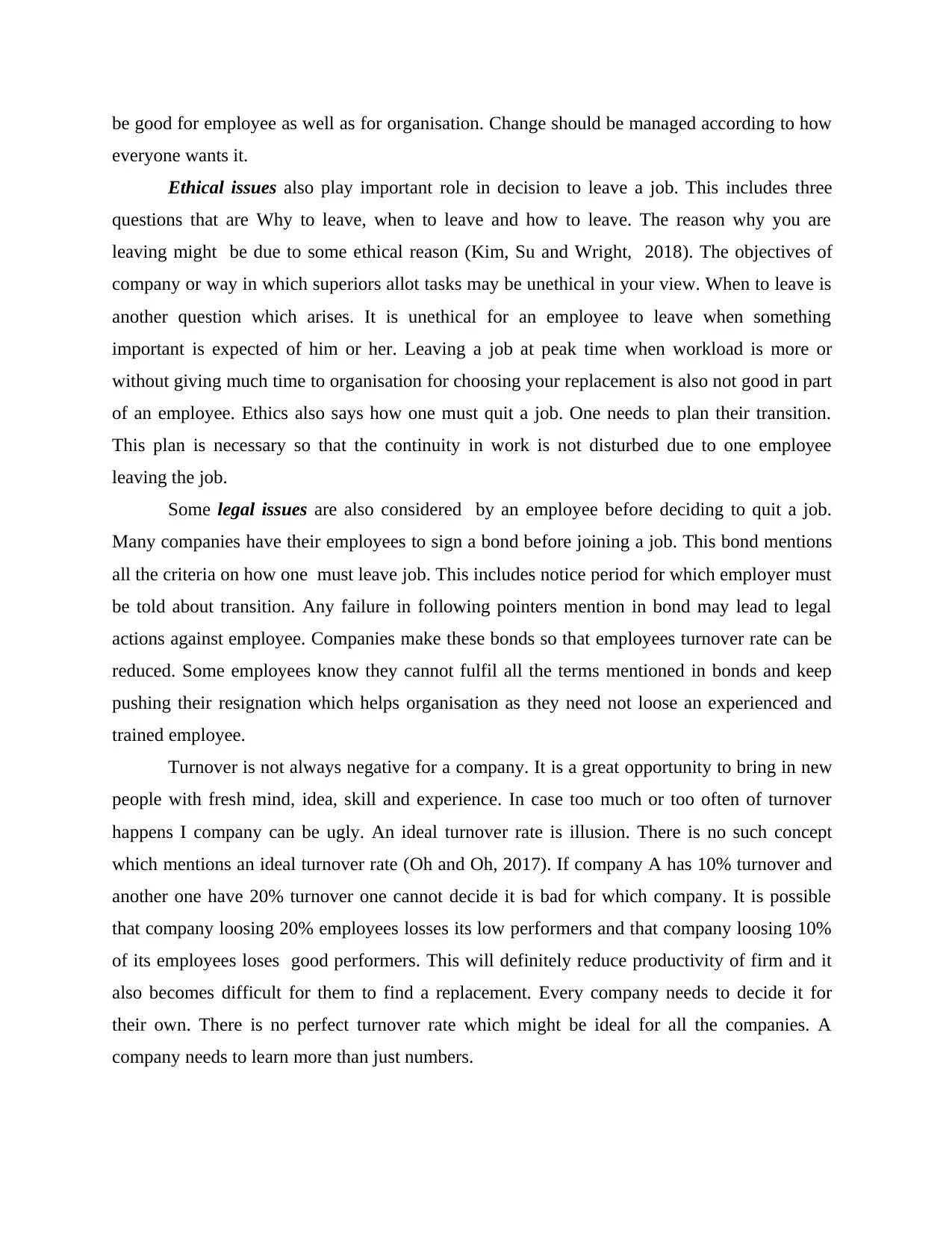
be good for employee as well as for organisation. Change should be managed according to how
everyone wants it.
Ethical issues also play important role in decision to leave a job. This includes three
questions that are Why to leave, when to leave and how to leave. The reason why you are
leaving might be due to some ethical reason (Kim, Su and Wright, 2018). The objectives of
company or way in which superiors allot tasks may be unethical in your view. When to leave is
another question which arises. It is unethical for an employee to leave when something
important is expected of him or her. Leaving a job at peak time when workload is more or
without giving much time to organisation for choosing your replacement is also not good in part
of an employee. Ethics also says how one must quit a job. One needs to plan their transition.
This plan is necessary so that the continuity in work is not disturbed due to one employee
leaving the job.
Some legal issues are also considered by an employee before deciding to quit a job.
Many companies have their employees to sign a bond before joining a job. This bond mentions
all the criteria on how one must leave job. This includes notice period for which employer must
be told about transition. Any failure in following pointers mention in bond may lead to legal
actions against employee. Companies make these bonds so that employees turnover rate can be
reduced. Some employees know they cannot fulfil all the terms mentioned in bonds and keep
pushing their resignation which helps organisation as they need not loose an experienced and
trained employee.
Turnover is not always negative for a company. It is a great opportunity to bring in new
people with fresh mind, idea, skill and experience. In case too much or too often of turnover
happens I company can be ugly. An ideal turnover rate is illusion. There is no such concept
which mentions an ideal turnover rate (Oh and Oh, 2017). If company A has 10% turnover and
another one have 20% turnover one cannot decide it is bad for which company. It is possible
that company loosing 20% employees losses its low performers and that company loosing 10%
of its employees loses good performers. This will definitely reduce productivity of firm and it
also becomes difficult for them to find a replacement. Every company needs to decide it for
their own. There is no perfect turnover rate which might be ideal for all the companies. A
company needs to learn more than just numbers.
everyone wants it.
Ethical issues also play important role in decision to leave a job. This includes three
questions that are Why to leave, when to leave and how to leave. The reason why you are
leaving might be due to some ethical reason (Kim, Su and Wright, 2018). The objectives of
company or way in which superiors allot tasks may be unethical in your view. When to leave is
another question which arises. It is unethical for an employee to leave when something
important is expected of him or her. Leaving a job at peak time when workload is more or
without giving much time to organisation for choosing your replacement is also not good in part
of an employee. Ethics also says how one must quit a job. One needs to plan their transition.
This plan is necessary so that the continuity in work is not disturbed due to one employee
leaving the job.
Some legal issues are also considered by an employee before deciding to quit a job.
Many companies have their employees to sign a bond before joining a job. This bond mentions
all the criteria on how one must leave job. This includes notice period for which employer must
be told about transition. Any failure in following pointers mention in bond may lead to legal
actions against employee. Companies make these bonds so that employees turnover rate can be
reduced. Some employees know they cannot fulfil all the terms mentioned in bonds and keep
pushing their resignation which helps organisation as they need not loose an experienced and
trained employee.
Turnover is not always negative for a company. It is a great opportunity to bring in new
people with fresh mind, idea, skill and experience. In case too much or too often of turnover
happens I company can be ugly. An ideal turnover rate is illusion. There is no such concept
which mentions an ideal turnover rate (Oh and Oh, 2017). If company A has 10% turnover and
another one have 20% turnover one cannot decide it is bad for which company. It is possible
that company loosing 20% employees losses its low performers and that company loosing 10%
of its employees loses good performers. This will definitely reduce productivity of firm and it
also becomes difficult for them to find a replacement. Every company needs to decide it for
their own. There is no perfect turnover rate which might be ideal for all the companies. A
company needs to learn more than just numbers.
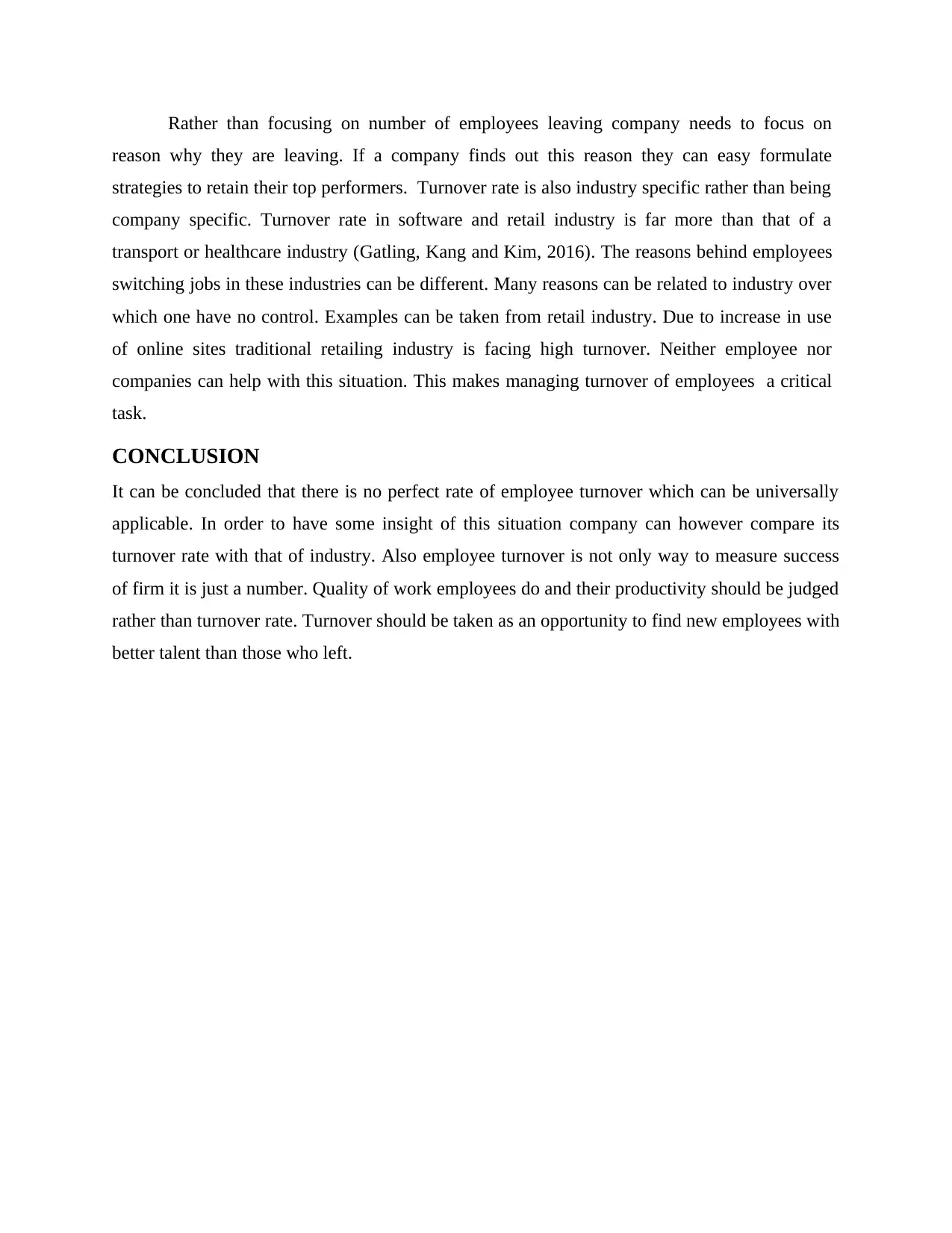
Rather than focusing on number of employees leaving company needs to focus on
reason why they are leaving. If a company finds out this reason they can easy formulate
strategies to retain their top performers. Turnover rate is also industry specific rather than being
company specific. Turnover rate in software and retail industry is far more than that of a
transport or healthcare industry (Gatling, Kang and Kim, 2016). The reasons behind employees
switching jobs in these industries can be different. Many reasons can be related to industry over
which one have no control. Examples can be taken from retail industry. Due to increase in use
of online sites traditional retailing industry is facing high turnover. Neither employee nor
companies can help with this situation. This makes managing turnover of employees a critical
task.
CONCLUSION
It can be concluded that there is no perfect rate of employee turnover which can be universally
applicable. In order to have some insight of this situation company can however compare its
turnover rate with that of industry. Also employee turnover is not only way to measure success
of firm it is just a number. Quality of work employees do and their productivity should be judged
rather than turnover rate. Turnover should be taken as an opportunity to find new employees with
better talent than those who left.
reason why they are leaving. If a company finds out this reason they can easy formulate
strategies to retain their top performers. Turnover rate is also industry specific rather than being
company specific. Turnover rate in software and retail industry is far more than that of a
transport or healthcare industry (Gatling, Kang and Kim, 2016). The reasons behind employees
switching jobs in these industries can be different. Many reasons can be related to industry over
which one have no control. Examples can be taken from retail industry. Due to increase in use
of online sites traditional retailing industry is facing high turnover. Neither employee nor
companies can help with this situation. This makes managing turnover of employees a critical
task.
CONCLUSION
It can be concluded that there is no perfect rate of employee turnover which can be universally
applicable. In order to have some insight of this situation company can however compare its
turnover rate with that of industry. Also employee turnover is not only way to measure success
of firm it is just a number. Quality of work employees do and their productivity should be judged
rather than turnover rate. Turnover should be taken as an opportunity to find new employees with
better talent than those who left.
⊘ This is a preview!⊘
Do you want full access?
Subscribe today to unlock all pages.

Trusted by 1+ million students worldwide
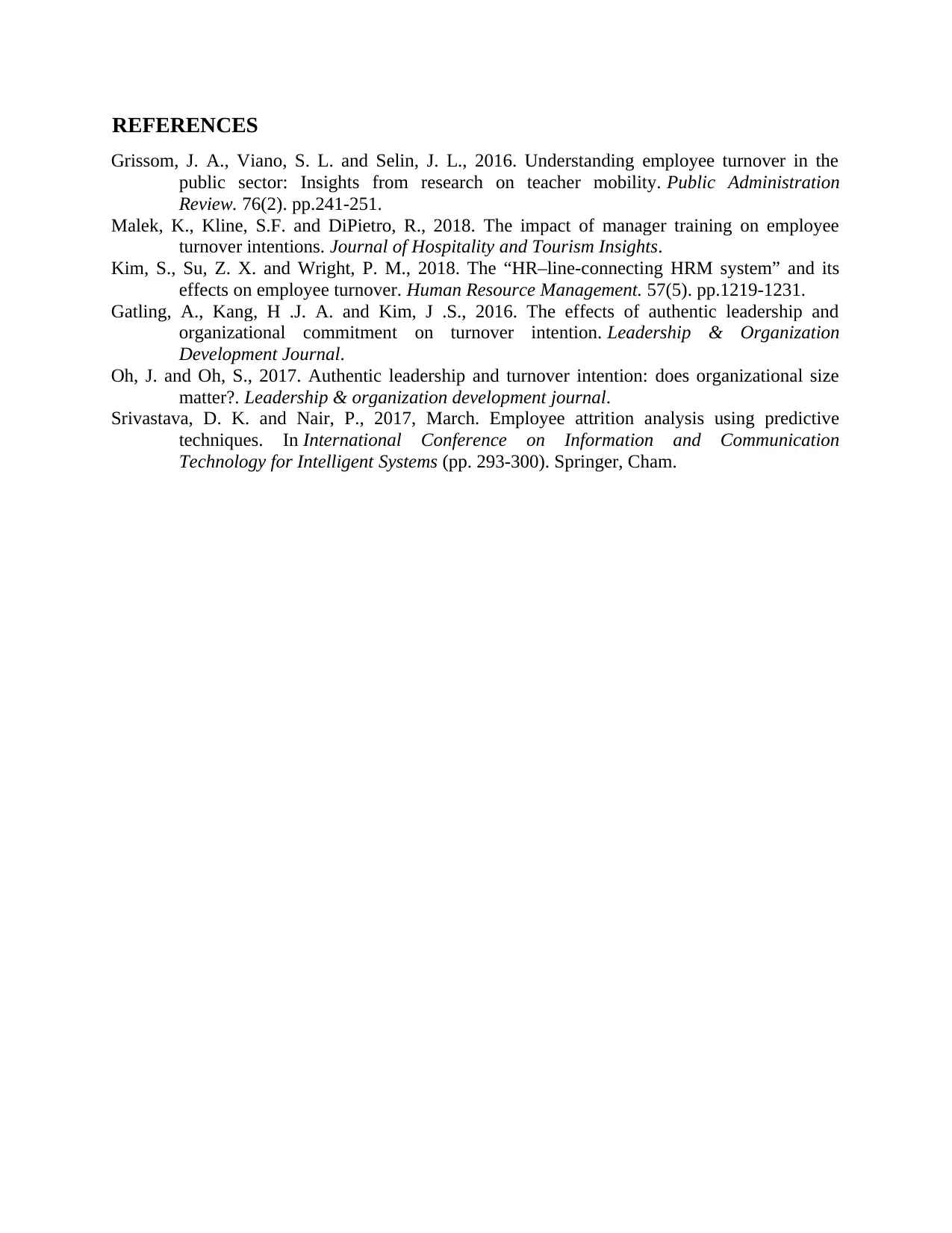
REFERENCES
Grissom, J. A., Viano, S. L. and Selin, J. L., 2016. Understanding employee turnover in the
public sector: Insights from research on teacher mobility. Public Administration
Review. 76(2). pp.241-251.
Malek, K., Kline, S.F. and DiPietro, R., 2018. The impact of manager training on employee
turnover intentions. Journal of Hospitality and Tourism Insights.
Kim, S., Su, Z. X. and Wright, P. M., 2018. The “HR–line‐connecting HRM system” and its
effects on employee turnover. Human Resource Management. 57(5). pp.1219-1231.
Gatling, A., Kang, H .J. A. and Kim, J .S., 2016. The effects of authentic leadership and
organizational commitment on turnover intention. Leadership & Organization
Development Journal.
Oh, J. and Oh, S., 2017. Authentic leadership and turnover intention: does organizational size
matter?. Leadership & organization development journal.
Srivastava, D. K. and Nair, P., 2017, March. Employee attrition analysis using predictive
techniques. In International Conference on Information and Communication
Technology for Intelligent Systems (pp. 293-300). Springer, Cham.
Grissom, J. A., Viano, S. L. and Selin, J. L., 2016. Understanding employee turnover in the
public sector: Insights from research on teacher mobility. Public Administration
Review. 76(2). pp.241-251.
Malek, K., Kline, S.F. and DiPietro, R., 2018. The impact of manager training on employee
turnover intentions. Journal of Hospitality and Tourism Insights.
Kim, S., Su, Z. X. and Wright, P. M., 2018. The “HR–line‐connecting HRM system” and its
effects on employee turnover. Human Resource Management. 57(5). pp.1219-1231.
Gatling, A., Kang, H .J. A. and Kim, J .S., 2016. The effects of authentic leadership and
organizational commitment on turnover intention. Leadership & Organization
Development Journal.
Oh, J. and Oh, S., 2017. Authentic leadership and turnover intention: does organizational size
matter?. Leadership & organization development journal.
Srivastava, D. K. and Nair, P., 2017, March. Employee attrition analysis using predictive
techniques. In International Conference on Information and Communication
Technology for Intelligent Systems (pp. 293-300). Springer, Cham.
1 out of 7
Related Documents
Your All-in-One AI-Powered Toolkit for Academic Success.
+13062052269
info@desklib.com
Available 24*7 on WhatsApp / Email
![[object Object]](/_next/static/media/star-bottom.7253800d.svg)
Unlock your academic potential
Copyright © 2020–2025 A2Z Services. All Rights Reserved. Developed and managed by ZUCOL.





